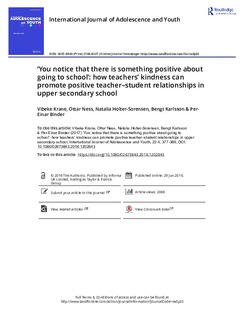| dc.contributor.author | Krane, Vibeke | |
| dc.contributor.author | Ness, Ottar | |
| dc.contributor.author | Holter-Sørensen, Natalia | |
| dc.contributor.author | Karlsson, Bengt Eirik | |
| dc.contributor.author | Binder, Per-Einar | |
| dc.date.accessioned | 2018-02-22T14:54:55Z | |
| dc.date.available | 2018-02-22T14:54:55Z | |
| dc.date.created | 2016-06-29T13:49:15Z | |
| dc.date.issued | 2016 | |
| dc.identifier.citation | International Journal of Adolescence and Youth. 2016, 22 (4), 377-389. | nb_NO |
| dc.identifier.issn | 0267-3843 | |
| dc.identifier.uri | http://hdl.handle.net/11250/2486576 | |
| dc.description.abstract | This study aimed to obtain students’ first-person perspectives of their experience of positive teacher–student relationships (TSRs) in upper secondary school. We also explored their experiences of qualities of TSRs concerning students’ mental health and dropout from upper secondary school. We used a qualitative and participative approach, whereby key stakeholders were included as co-researchers. Seventeen students participated in semi-structured individual interviews and focus groups. Interview data were analysed via thematic analysis. Participants’ experiences were clustered around five themes: (1) it takes two: mutual responsibility in TSRs, (2) don’t be unfair: negative experiences challenge TSRs, (3) talk to us: bonding and problem solving through conversation, (4) help us: adapting to students’ academic and personal needs, and (5) we need kind teachers: the importance of teachers’ demeanour. The findings demonstrated the value of positive TSRs and illustrated the ways in which they promote students’ well-being at school. | nb_NO |
| dc.language.iso | eng | nb_NO |
| dc.rights | Navngivelse 4.0 Internasjonal | * |
| dc.rights.uri | http://creativecommons.org/licenses/by/4.0/deed.no | * |
| dc.title | ‘You notice that there is something positive about going to school’: how teachers’ kindness can promote positive teacher–student relationships in upper secondary school | nb_NO |
| dc.type | Journal article | nb_NO |
| dc.type | Peer reviewed | nb_NO |
| dc.description.version | publishedVersion | nb_NO |
| dc.rights.holder | 2016 The Authors | nb_NO |
| dc.source.pagenumber | 377-389 | nb_NO |
| dc.source.volume | 22 | nb_NO |
| dc.source.journal | International Journal of Adolescence and Youth | nb_NO |
| dc.source.issue | 4 | nb_NO |
| dc.identifier.doi | 10.1080/02673843.2016.1202843 | |
| dc.identifier.cristin | 1364994 | |
| cristin.unitcode | 222,56,3,0 | |
| cristin.unitcode | 222,56,1,0 | |
| cristin.unitname | Institutt for helse-, sosial- og velferdsfag | |
| cristin.unitname | Institutt for sykepleie- og helsevitenskap | |
| cristin.ispublished | true | |
| cristin.fulltext | original | |
| cristin.qualitycode | 1 | |

